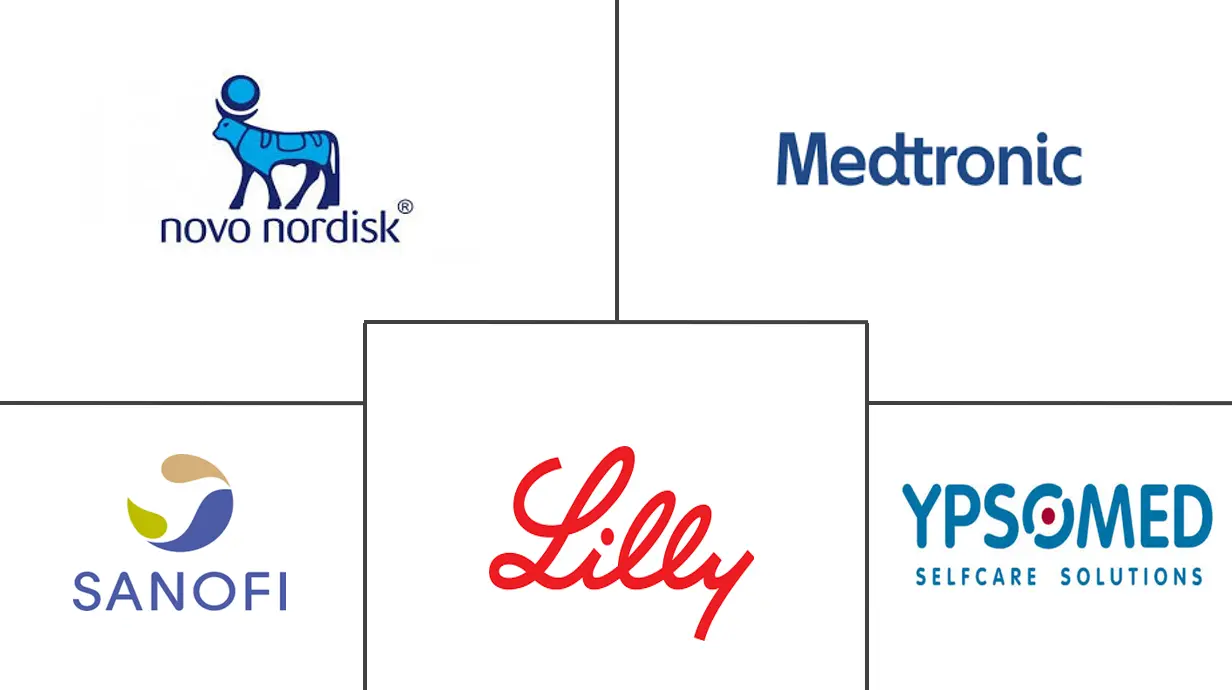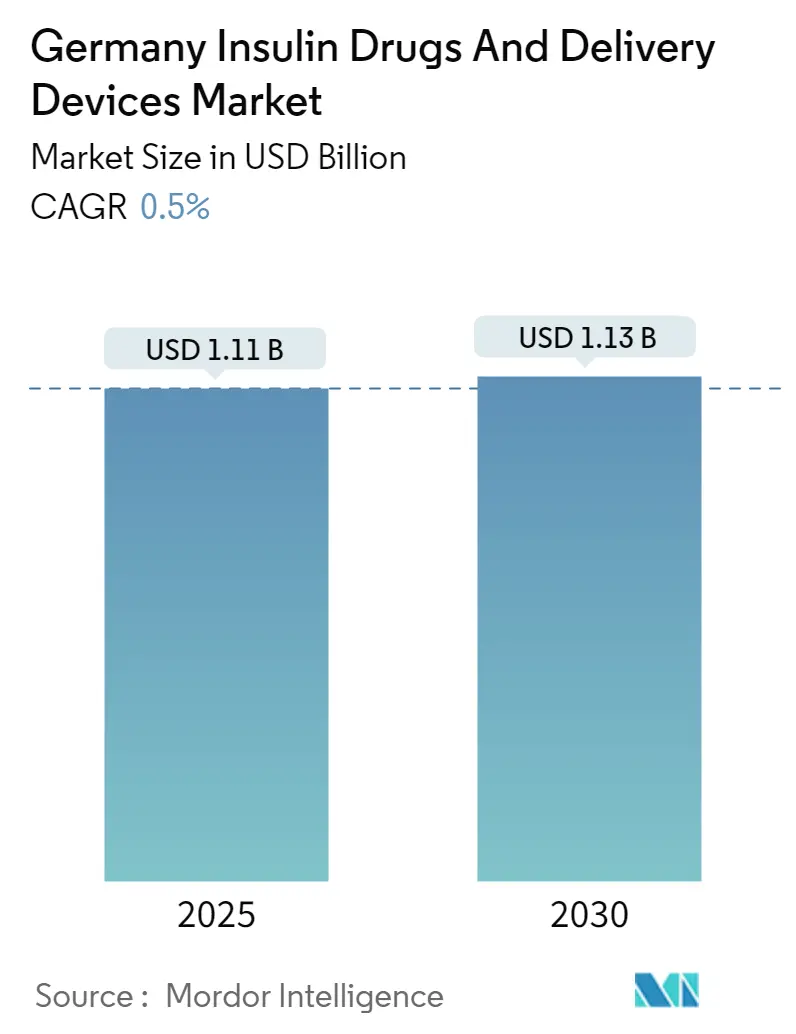
Germany Insulin Drugs And Delivery Devices Market Analysis by Mordor Intelligence
The Germany Insulin Drugs And Delivery Devices Market size is estimated at USD 1.11 billion in 2025, and is expected to reach USD 1.13 billion by 2030, at a CAGR of 0.5% during the forecast period (2025-2030).
One of the most significant risk factors for a severe course of COVID-19 is diabetes mellitus. This risk is believed to be influenced by several variables that are frequently present in diabetes mellitus, such as advanced age, a proinflammatory and hypercoagulable condition, hyperglycemia, and underlying comorbidities (hypertension, cardiovascular disease, chronic kidney disease, and obesity). Diabetes was quickly recognized as a risk factor for bad results during the COVID-19 pandemic. That's why managing or delaying cases of type 2 diabetes became more important than ever before. Several studies have confirmed that chronic diseases like diabetes are associated with adverse outcomes in COVID-19 patients.
Diabetes is associated with many health complications. Comparing the population with and without diabetes, those with diabetes have a 300% increased risk of being hospitalized and, thus, incur more healthcare expenses compared to non-diabetic people. People with diabetes face a higher chance of experiencing serious complications from COVID-19. In general, people with diabetes are more likely to experience severe symptoms and complications when infected with a virus. Diabetes and high glucose levels are associated with increased complications, respiratory failure, and mortality in hospitalized patients with coronavirus.
Germany is one of the developed countries and advanced in terms of healthcare facilities. Technologies, such as continuous glucose monitoring and insulin infusion pumps, are getting more adopted rapidly in Germany than the other developing countries. Moreover, the reimbursement policy and the pricing policy are highly regulated, which drives the market and increases the adoption rate of new and advanced technologies. The pandemic also highlighted opportunities for continuing and expanding innovations in the delivery of diabetes care, through virtual consultations between healthcare providers and people with diabetes, and the use of diabetes technology. Crisis management has created unprecedented interest in remote care from both patients and providers and removed many long-standing regulatory barriers. Thus, the COVID-19 outbreak increased the insulin market's growth.
Germany Insulin Drugs And Delivery Devices Market Trends and Insights
Rising diabetes prevalence
In Germany, the diabetes population is expected to increase with a CAGR greater than 0.48% over the forecast period.
According to the German Diabetes Centre (DDZ) 2022, about 8.5 million people in Germany are affected by diabetes. The number of people with type 2 diabetes in Germany will continue to increase over the next twenty years. Researchers at DDZ estimate that up to twelve million people might suffer from metabolic disorders in 2040. Germany is one of the developed countries and advanced healthcare facilities. Technologies, such as continuous glucose monitoring and insulin infusion pumps, are getting more rapidly adopted in Germany than the other developing countries. Moreover, the reimbursement and pricing policies are highly regulated, facilitating the adoption rate of new and advanced technologies.
German law requires public plans to cap out-of-pocket health care costs and to cover all medically necessary treatment, including insulin drugs. German diabetes patients have some of the lowest out-of-pocket costs in the world, according to T1 International, an advocacy group for people with diabetes. Stringent government policies and favorable regulations by WHO in Germany are encouraging companies to develop innovative products. Penetration of these products in the German market supports local clinical research organizations in their clinical research trials and ensures ease of management, facilitating the discovery process. Leading manufacturers focus on technological innovations and develop advanced products to gain a substantial market share. There has been a significant rise in insulin delivery systems technology, from insulin injections to insulin pumps. Technological innovations and advancements offer many conveniences in maintaining blood glucose levels.
Therefore, owing to the increasing diabetes prevalence,e the studied market is anticipated to grow over the analysis period.
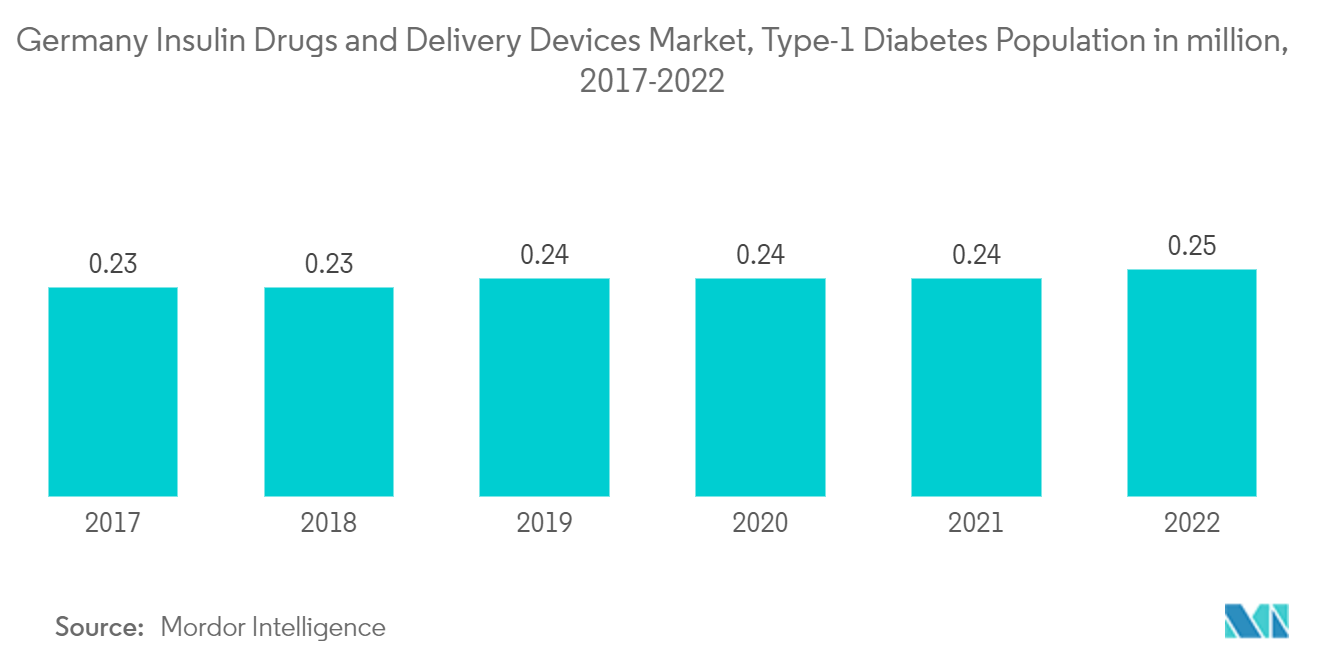
The insulin pumps segment is expected to witness the highest growth rate over the forecast period
The insulin pumps segment holds a major market share in the insulin delivery devices market in the current year and is expected to grow with a CAGR of about 2.7% in the market over the forecast period because of the increasing technological advancement and its preference over other traditional methods due to continuous insulin administration.
An insulin pump is a device that delivers insulin continuously or, whenever required, automatically. The pump mimics the human pancreas. The insulin infusion pump works as an alternative to the traditional system of daily injections or an insulin pen. Insulin pump therapy is a well-established insulin administration method for T1DM people. Pumps are a validated, time-tested therapeutic option in T1DM at all ages, enabling near-physiological insulin delivery in situations where the pancreas does not produce insulin. There are even pump models with remote controls enabling parents of young children to either suspend or bolus insulin from a distance when the child is playing or eating. The insulin infusion pumps reduce the large swings in blood glucose levels, induce less pain, and deliver more accurately when compared to injections. These advantages of insulin pumps over the traditional delivery system are expected to boost the market.
The frequency of monitoring glucose levels depends on the type of diabetes, which varies from patient to patient. Type-1 diabetic patients must check their blood glucose levels regularly, monitor their blood glucose levels, and adjust the insulin dosing accordingly, likely to drive segment growth during the forecast period. Continuous subcutaneous insulin infusion and continuous glucose monitoring systems have improved patient care and quality of life and are widely used in the ambulatory setting. Increasingly, this technology is also being used in the hospital setting.
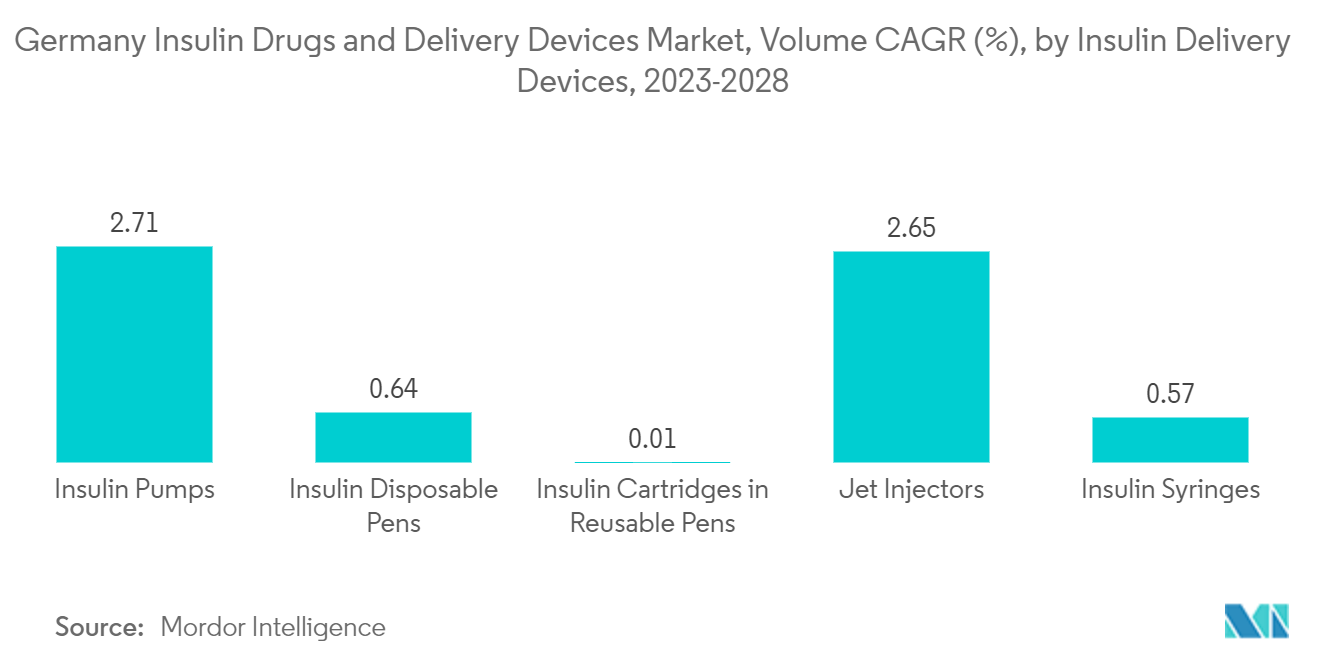
Competitive Landscape
The Germany Insulin Drugs and Delivery Devices Market is moderately consolidated, with few significant and generic players. Mergers and acquisitions between the players recently have helped the companies strengthen their market presence. Eli Lilly and Boehringer Ingelheim have an alliance in developing and commercializing Basaglar (Insulin Glargine). Additionally, the players in the recent past helped the companies strengthen their market presence; for example, Novo Nordisk collaborated with Ypsomed to provide better insulin therapy solutions.
Germany Insulin Drugs And Delivery Devices Industry Leaders
Medtronic
Ypsomed
Novo Nordisk A/S
Eli Lilly and Company
Sanofi Aventis
- *Disclaimer: Major Players sorted in no particular order
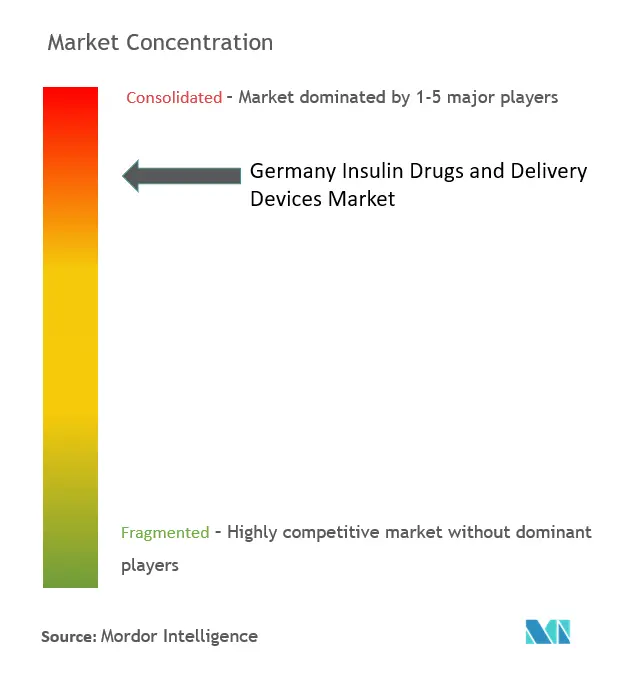
Recent Industry Developments
- November 2022: Ypsomed's mylife Loop is now authorized to work with Abbott's FreeStyle Libre 3 sensor in Germany. The mylife YpsoPump and the FreeStyle Libre 3, combined with the mylife CamAPS FX algorithm from CamDiab, form an automated insulin delivery system designed to help people with type 1 diabetes to better control their glucose levels and alleviate the burden of daily diabetes management.
- January 2022: German biotech company Evotec announced it had collaborated with Eli Lilly on drug discovery in metabolic diseases. The total potential value of the collaboration, which will run for three years, is up to USD 1 billion. As part of the collaboration, Evotec will explore potential drug candidates for treating diabetes and chronic liver disease.
Germany Insulin Drugs And Delivery Devices Market Report Scope
Insulin is mainly used to treat type 1 diabetes but can be used in people with type 2 diabetes if insulin levels remain low despite using other medications. There are different ways to inject insulin into a patient's body, using syringes, pens, pumps, and jet injectors, giving them various options for insulin delivery. The Germany Insulin Drugs and Delivery Devices Market is segmented into Drugs (Basal or Long-acting Insulins, Bolus or Fast-acting Insulins, Traditional Human Insulins, Combination Insulins, and Biosimilar Insulins), Devices (Insulin Pens, Insulin Pumps, Insulin Syringes, and Jet Injectors). The report offers the value (in USD million) and volume (in million mL) for insulin drugs and (in unit million) for the devices for the above segments.
| Basal or Long-acting Insulins | Lantus (Insulin Glargine) | |
| Levemir (Insulin Detemir) | ||
| Toujeo (Insulin Glargine) | ||
| Tresiba (Insulin Degludec) | ||
| Basaglar (Insulin Glargine) | Other drugs | |
| Bolus or Fast-acting Insulins | NovoRapid/Novolog (Insulin aspart) | |
| Humalog (Insulin lispro) | ||
| Apidra (Insulin glulisine) | ||
| FIASP (Insulin aspart) | ||
| Admelog (Insulin lispro Sanofi) | ||
| Traditional Human Insulins | Novolin/Mixtard/Actrapid/Insulatard | |
| Humulin | ||
| Insuman | ||
| Combination Insulins | NovoMix (Biphasic Insulin aspart) | |
| Ryzodeg (Insulin degludec and Insulin aspart) | ||
| Xultophy (Insulin degludec and Liraglutide) | ||
| Soliqua/Suliqua (Insulin glargine and Lixisenatide) | ||
| Biosimilar Insulins | Insulin Glargine Biosimilars | |
| Human Insulin Biosimilars | ||
| Insulin Pumps | Insulin Pump Devices |
| Insulin Pump Reservoirs | |
| Insulin Infusion sets | |
| Insulin Pens | Cartridges in reusable pens |
| Disposable insulin pens | |
| Insulin Syringes | |
| Insulin Jet Injectors |
| Drug | Basal or Long-acting Insulins | Lantus (Insulin Glargine) | |
| Levemir (Insulin Detemir) | |||
| Toujeo (Insulin Glargine) | |||
| Tresiba (Insulin Degludec) | |||
| Basaglar (Insulin Glargine) | Other drugs | ||
| Bolus or Fast-acting Insulins | NovoRapid/Novolog (Insulin aspart) | ||
| Humalog (Insulin lispro) | |||
| Apidra (Insulin glulisine) | |||
| FIASP (Insulin aspart) | |||
| Admelog (Insulin lispro Sanofi) | |||
| Traditional Human Insulins | Novolin/Mixtard/Actrapid/Insulatard | ||
| Humulin | |||
| Insuman | |||
| Combination Insulins | NovoMix (Biphasic Insulin aspart) | ||
| Ryzodeg (Insulin degludec and Insulin aspart) | |||
| Xultophy (Insulin degludec and Liraglutide) | |||
| Soliqua/Suliqua (Insulin glargine and Lixisenatide) | |||
| Biosimilar Insulins | Insulin Glargine Biosimilars | ||
| Human Insulin Biosimilars | |||
| Device | Insulin Pumps | Insulin Pump Devices | |
| Insulin Pump Reservoirs | |||
| Insulin Infusion sets | |||
| Insulin Pens | Cartridges in reusable pens | ||
| Disposable insulin pens | |||
| Insulin Syringes | |||
| Insulin Jet Injectors | |||
Key Questions Answered in the Report
How big is the Germany Insulin Drugs And Delivery Devices Market?
The Germany Insulin Drugs And Delivery Devices Market size is expected to reach USD 1.11 billion in 2025 and grow at a CAGR of 0.5% to reach USD 1.13 billion by 2030.
What is the current Germany Insulin Drugs And Delivery Devices Market size?
In 2025, the Germany Insulin Drugs And Delivery Devices Market size is expected to reach USD 1.11 billion.
Who are the key players in Germany Insulin Drugs And Delivery Devices Market?
Medtronic, Ypsomed, Novo Nordisk A/S, Eli Lilly and Company and Sanofi Aventis are the major companies operating in the Germany Insulin Drugs And Delivery Devices Market.
What years does this Germany Insulin Drugs And Delivery Devices Market cover, and what was the market size in 2024?
In 2024, the Germany Insulin Drugs And Delivery Devices Market size was estimated at USD 1.10 billion. The report covers the Germany Insulin Drugs And Delivery Devices Market historical market size for years: 2019, 2020, 2021, 2022, 2023 and 2024. The report also forecasts the Germany Insulin Drugs And Delivery Devices Market size for years: 2025, 2026, 2027, 2028, 2029 and 2030.
Page last updated on:
Germany Insulin Drugs And Delivery Devices Market Report
Statistics for the 2025 Germany Insulin Drugs And Delivery Devices market share, size and revenue growth rate, created by Mordor Intelligence™ Industry Reports. Germany Insulin Drugs And Delivery Devices analysis includes a market forecast outlook for 2025 to 2030 and historical overview. Get a sample of this industry analysis as a free report PDF download.
